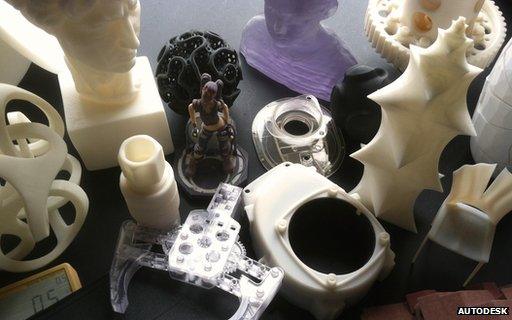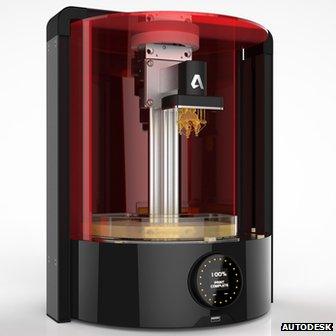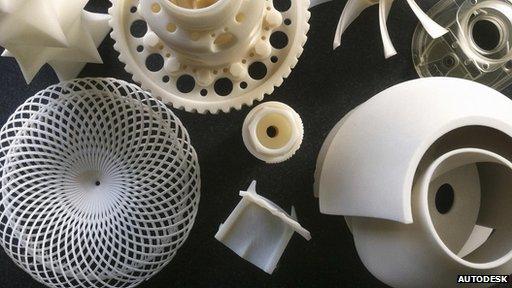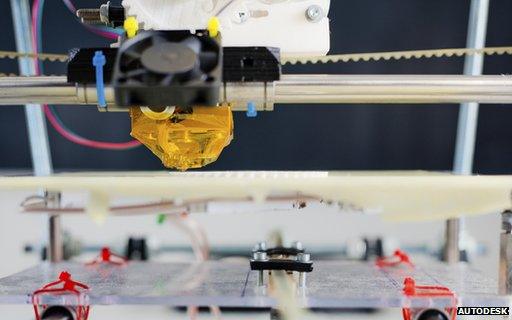Autodesk unveils 3D printer as it aims to become industry's Android
- Published

Autodesk highlights the smooth surface of objects created by its printer
Autodesk - the leading 3D modelling software-maker - is going into hardware with its own 3D printer.
Chief executive Carl Bass revealed the news ahead of an appearance at the MakerCon conference in California.
In addition to selling the machine, Autodesk will also allow other manufacturers to make their own versions of the printer or power their own models off its software at no cost.
Mr Bass likened the move to the way Google had driven adoption of Android.
One analyst said the effort should encourage adoption of the technology.

Autodesk's printer uses a laser to harden liquid plastic to create the objects
"The printer is a bona fide attempt to prove the interoperability and open source nature of Autodesk's platform," said Pete Basiliere, research director at the Gartner tech agency.
"And by sharing its design we could see a second wave of small start-ups creating stereolithography machines just as the makers did when the early material extrusion patents expired."
Stereolithography 3D printers create objects by using a laser to harden liquid plastic.
The ultraviolet light traces a cross-section of the desired design over a thin exposed layer of plastic resin, turning it solid, before the unused material is disposed of. This process is repeated layer-by-layer until the object is complete.
This differs from the extrusion technique most commonly used by existing budget printers, which involves building an object by squeezing melted plastic out of a tiny nozzle.
The Stereolithographic process is more complicated to achieve, but can deliver smoother, more complex and more detailed objects.
Only about 56,500 3D-printers priced under $100,000 (£59,576) were sold last year, according to Gartner, external.
However, it predicts that number will grow to about 200,000 units next year and then continue to experience "explosive growth" with business purchases initially accounting for most of the demand.
Android ambition
Mr Bass compares the new printer to Google's first Nexus smartphone, a product meant to inspire other manufacturers to install Android on their handsets rather than become a bestseller itself.
In Autodesk's case the idea is to drive the adoption of its new Spark software, a product it likens to being an "operating system for 3D-printing".

The stereolithography printing technique allows complex designs to be created
Mr Bass told the BBC that he hoped others would take advantage of this to improve the 3D tech.
"One of the limitations right now is on the material sciences side - the kind of chemistry," he said.
"We're making a printer that, rather than just being able to load in proprietary materials, you can load in any material you want. You can formulate your own polymers and experiment with those.
"That's an important next step because we think material science is a breakthrough that has to happen to make [the industry] go from low-volume 3D-printed stuff to where it really starts changing manufacturing."
He added that although he was giving away both Spark and the printer's design, Autodesk should still profit because the move would drive demand for the firm's other products
"If 3D printing succeeds we succeed, because the only way you can print is if you have a 3D model, and our customers are the largest makers of 3D models in the world," he said.
"My feeling is that 3D printing has been over-hyped for home use but under-appreciated for its industrial possibilities.
"I think we're really at the beginning of a new way of making stuff and we're just trying to kickstart it."

Autodesk's printer can be used with the customer's own customised plastic "ink"
Autodesk has yet to announce the price and launch date for its printer.
- Published7 May 2014

- Published25 April 2014

- Published8 April 2014
